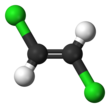1,2-Dichloroethylene
Appearance
| |||
| |||
| Names | |||
|---|---|---|---|
| Preferred IUPAC name
1,2-Dichloroethene | |||
| Other names
1,2-Dichloroethene
1,2-DCE Acetylene dichloride sym-Dichloroethylene | |||
| Identifiers | |||
3D model (
JSmol ) |
|||
| ChEBI | |||
| ChemSpider | |||
ECHA InfoCard
|
100.007.956 | ||
| EC Number |
| ||
| KEGG | |||
PubChem CID
|
|||
| UNII |
| ||
CompTox Dashboard (EPA)
|
|||
| |||
| |||
| Properties | |||
| C2H2Cl2 | |||
| Molar mass | 96.95 g/mol | ||
| Appearance | colorless liquid | ||
| Odor | sweet[1] | ||
| Density | Z: 1.28 g/cm3 E: 1.26 g/cm3 | ||
| Melting point | Z: −81.47 °C E: −49.44 °C | ||
| Boiling point | Z: 60.2 °C E: 48.5 °C | ||
| |||
| Z: 1.9 D E: 0 D | |||
| Hazards | |||
| Flash point | 2–4 °C; 36–39 °F; 275–277 K | ||
Explosive limits
|
5.6–12.8%[2] | ||
| Lethal dose or concentration (LD, LC): | |||
LD50 (median dose)
|
770 mg/kg (oral, rat) 1275 mg/kg (oral, rat, trans-isomer)[3] | ||
LC50 (median concentration)
|
21,273 ppm (mouse, 6 hr, trans-isomer)[3] | ||
LCLo (lowest published)
|
16,000 ppm (rat, 6 hr, cis-isomer)[3] | ||
| NIOSH (US health exposure limits): | |||
PEL (Permissible)
|
TWA 200 ppm (790 mg/m3)[2] | ||
REL (Recommended)
|
TWA 200 ppm (790 mg/m3)[2] | ||
IDLH (Immediate danger) |
1000 ppm[2] | ||
Except where otherwise noted, data are given for materials in their standard state (at 25 °C [77 °F], 100 kPa).
| |||
1,2-Dichloroethylene or 1,2-DCE is the name for a pair of
geometric isomers, cis-1,2-dichloroethene or trans-1,2-dichloroethene, but is often used as a mixture of the two. They have modest solubility in water. These compounds have some applications as a degreasing solvent.[1] In contrast to most cis-trans compounds, the Z isomer (cis) is more stable than the E isomer (trans) by 0.4 kcal/mol.[4]
Production, uses and reactions
cis-DCE, the Z isomer, is obtainable by the controlled
chlorination of acetylene
:
- C2H2 + Cl2 → C2H2Cl2
Industrially both isomers arise as byproducts of the production of
1,1-dichloroethylene, the 1,2-dichloroethylene isomers do not polymerize.[1]
trans-1,2-DCE has applications including electronics cleaning, precision cleaning, and certain metal cleaning applications.[5]
Both isomers participate in
cycloaddition reactions.[6]
Safety and environmental concerns
These compounds have "moderate oral toxicity to rats".[1]
The dichloroethylene isomers occur in some polluted waters and soils, as the decomposition products of trichloroethylene. Significant attention has been paid to their further degradation, e.g. by iron particles.[7][8]
See also
- 1,1-Dichloroethene
- 1,2-Dichloroethane, which is also often abbreviated as 1,2-DCE
References
- ^ ISBN 978-3527306732.
- ^ a b c d e NIOSH Pocket Guide to Chemical Hazards. "#0195". National Institute for Occupational Safety and Health (NIOSH).
- ^ a b c "1,2-Dichloroethylene". Immediately Dangerous to Life or Health Concentrations (IDLH). National Institute for Occupational Safety and Health (NIOSH).
- .
- ^ "Chlorinated Solvents and Feed Stock - Axiall". Archived from the original on 2016-04-08. Retrieved 2016-03-23.
- .
- PMID 20146755.
- .
External links
- International Chemical Safety Card 0436
- NIOSH Pocket Guide to Chemical Hazards. "#0195". National Institute for Occupational Safety and Health (NIOSH).




